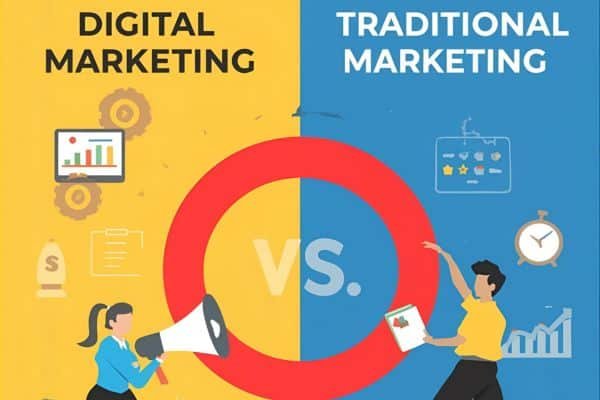A beginner’s guide to digital marketing vs. traditional marketing, explained simply. Discover the key differences, advantages, and effective strategies to select the ideal marketing approach for your business.
Table of Contents
If you’re new to the world of marketing, you’ve probably heard people debating digital marketing vs. traditional marketing. Honestly, it feels like watching a cricket match—both sides have loyal fans, but the real question is, which one works best for you? Let’s break it down in the simplest way possible.

What is Traditional Marketing?
Traditional marketing is the old-school method we all grew up with. Remember those giant billboards staring at you on the way to school or the catchy TV ads that made you hum the jingle all day? Yep, that’s traditional marketing in action.
It includes:
- TV and radio ads
- Newspaper and magazine promotions
- Posters, flyers, and banners
- Even those irritating telemarketing calls
It’s simple, familiar, and still works well for local reach. But here’s the catch—measuring its success is like finding a needle in a haystack.
What is Digital Marketing?
Now, on the other hand, digital marketing is like marketing on steroids—but smarter! It uses the internet to reach people. Think:
- Social media ads on Instagram or Facebook
- Ranking your website on Google through SEO
- Running YouTube campaigns
- Sending personalized email offers
The beauty of digital marketing is that it’s cost-friendly and laser-focused. You can target exactly who you want: age, location, interests—almost like you’re reading minds (but legally).
Digital Marketing vs Traditional Marketing: The Key Differences
Let’s compare both so it’s crystal clear:
| Feature | Traditional Marketing | Digital Marketing |
| Reach | Mostly local | Global |
| Cost | Expensive (TV, print) | Flexible & budget-friendly |
| Tracking | Hard to measure | Easy with analytics |
| Speed | Slower results | Faster, often instant |
| Interaction | One-way | Two-way (likes, shares, comments) |
So, while traditional marketing casts a wide net, digital marketing hands you a fishing rod and says, “Go catch exactly what you want.”
Which One Should You Choose?
Here comes the tricky part. When comparing digital marketing vs. traditional marketing, the answer isn’t always one-size-fits-all.
- If you’re a local business, like a café, salon, or coaching institute, a dash of traditional marketing (flyers or posters) can work wonders.
- But if you want to grow faster, get clients online, or start freelancing, digital marketing is your best buddy.
💡 Pro Tip: Mix both worlds! A clever blend of online and offline tactics can help your brand become memorable.
Final Thoughts
At the end of the day, digital marketing vs traditional marketing isn’t about picking a winner—it’s about choosing what aligns with your goals, budget, and audience. Traditional methods still hold value, but digital marketing gives you more control, better data, and quicker results.
So, whether you’re planning to build a small local brand or aiming to go global, remember this: marketing is less about shouting louder and more about connecting smarter. And that’s exactly what digital marketing helps you do.
Discover our advanced digital marketing course fees in Kolkata
FAQs on Digital Marketing vs Traditional Marketing
-
Which is better: Digital Marketing or Traditional Marketing?
Both have their advantages. Traditional marketing works best for local visibility, while digital marketing gives you global reach, measurable results, and budget flexibility. For most beginners, digital marketing is a smarter choice.
-
Is Digital Marketing cheaper than Traditional Marketing?
Yes, digital marketing is usually more cost-effective. Running Facebook or Google ads can be done with a small budget, whereas traditional ads, such as TV, print, or billboards, often require significant investments.
-
Can small businesses use both Digital and Traditional Marketing together?
Absolutely! A smart mix of both works wonders. For example, a café can use flyers for local reach while running Instagram ads to attract younger audiences. The best outcomes are frequently obtained using this hybrid approach.

